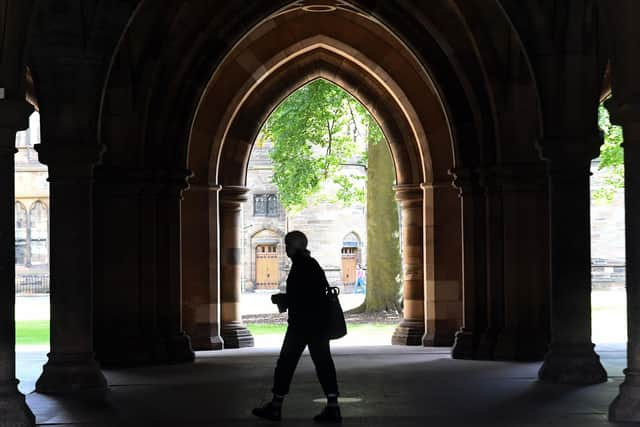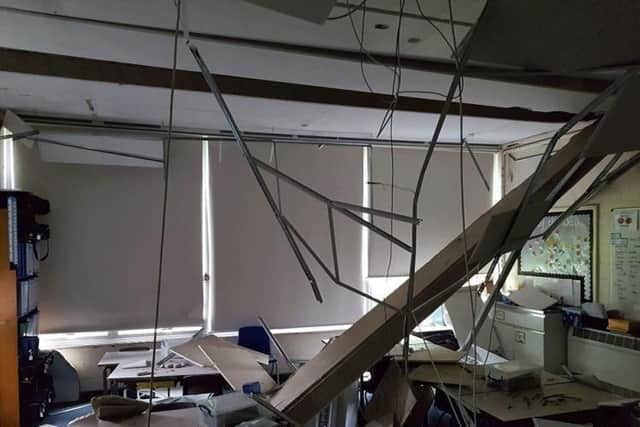Exclusive:Raac concrete Scotland: Scottish Government held series of 'secret' meetings to discuss dangerous concrete in universities and colleges
Scottish Government officials started holding a series of “secretive” meetings about dangerous Raac concrete in universities and colleges more than six months ago, it has emerged.
Four meetings were held between March and July, but the Government is under fire after revealing there are no minutes, agendas or papers for three of them.
Advertisement
Hide AdAdvertisement
Hide AdThe talks involved Government officials and the Scottish Funding Council (SFC), which oversees the nation’s higher and further education institutions.


Scottish Liberal Democrat leader Alex Cole-Hamilton said the meetings suggest civil servants already knew that reinforced autoclaved aerated concrete (Raac) was a “big problem” as far back as the spring, but “wasted” several months where action could be taken.
The weak concrete material has now been found in at least 29 sites across 11 universities and colleges in Scotland, as well as 40 schools. The material is thought to be in more than 250 NHS buildings.
Emails relating to a meeting between the Government and SFC on March 3 show that the gathering was arranged because there had been a “request from SG (Scottish Government) for information” and also to discuss “the potential for a common script approach” on Raac.
However, in response to a Freedom of Information request from the Lib Dems, the Government said: “No formal agenda or meeting notes were taken since the meeting was an informal meeting. No papers were tabled at the meeting.”


Subsequent meetings to discuss Raac involving the SFC and Government were held on April 26, June 15 and July 5.
For the June 15 meeting, no documentation exists beyond brief emails from civil servants arranging it, and there was also no formal agenda, minutes or papers for the July 5 talks.
The other meeting in April involved a presentation from NHS officials on its experience with Raac.
Advertisement
Hide AdAdvertisement
Hide AdA parliamentary question has suggested it was not until August 8 the SFC wrote to all college and university principals “highlighting the issue” of Raac and explaining “where they can find guidance on the identification and assessment of Raac”.


Three weeks later, on August 31, a shock decision by the UK Government to order the closure of more than 100 schools in England led to fresh concerns about Raac, and scrutiny of the Scottish Government’s response.
SNP ministers have criticised their counterparts at Westminster for alarming the public about Raac.
However, Mr Cole-Hamilton said the series of secret meetings suggested they had not been upfront with the public about the scale of the problem, and they were slow to act.
“If the Scottish Government wants to win over parents sceptical about the safety of the college and universities in which their kids are learning, this is not the way to do it,” he said.
"Their calls for public bodies to take a ‘common script approach’ suggest they were more concerned about public relations than public safety.
"This was clearly a big enough issue to draw the attention of a phalanx of senior civil servants, yet it took research by Scottish Liberal Democrats to reveal last week more than two dozen college and university sites where Raac is in place.
“The existence of secretive and unminuted meetings suggest that civil servants already knew that this was a big problem back in the spring, yet ministers wasted the whole summer without kick-starting a national programme to remove this dangerous concrete.
Advertisement
Hide AdAdvertisement
Hide Ad"A concrete beam in Dunblane previously deemed safe has since collapsed. Not only do we need a national fund to remove Raac from our public buildings, we need total transparency about how the Scottish Government arrived at its present position that these buildings are somehow safe for students to learn in.”
Raac was used in construction between the 1950s and 1990s, but an alert was issued in the UK after a school roof collapsed in 2018.
The Scotsman previously revealed West Lothian Council had taken the unusual step of warning all Scottish local authorities about the problems it had found with Raac in its buildings in 2021, while the Scottish Fire and Rescue Service highlighted the issue with the Scottish Government more than a year ago.
In September 2022, the Office of Government Property sent a safety briefing notice to all property leaders, stating: “Raac is now life-expired and liable to collapse.”
The UK Government’s decision to close English schools was partly influenced by a falling roof plank in April at Queen Victoria School in Dunblane, run by the Ministry of Defence, although Scottish ministers have said they were not informed of the incident.
The Scotsman reported in May that more than 20 rooms at Preston Lodge High School in East Lothian had been closed off following the discovery of Raac.
Last week, Forres Academy in Moray shut for two days while staff put contingency plans in place, while Motherwell Concert Hall and Theatre was closed, and Edinburgh City Council confirmed the capital’s Blackhall Library would shut while Raac was assessed.
A Scottish Government spokesperson said: “The Scottish Government has been engaging with the Scottish Funding Council (SFC) and other partners on Raac for some time now.
Advertisement
Hide AdAdvertisement
Hide Ad"Whilst work to date indicates that Raac is present in a relatively small proportion of the higher education estate, the safety of staff and students in our colleges and universities remains of paramount importance.
"Institutions should take a risk-based approach to managing and mitigating any risk using the guidance from the Institution of Structural Engineers.
“Scottish Government officials are in regular contact with the SFC on a range of issues and, where meetings are informal, papers may not necessarily be tabled or formal notes taken.”
Comments
Want to join the conversation? Please or to comment on this article.
